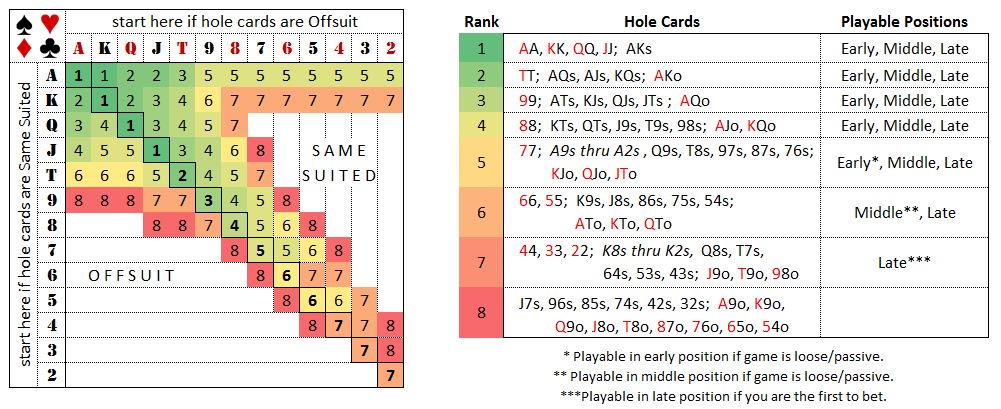In the competitive world of poker, understanding and utilizing a poker chart is essential for players aiming to enhance their strategies and improve their chances of winning. Poker serve as vital tools that provide structured information about various aspects of the game, from betting strategies to hand rankings. They help players make informed decisions, whether they are playing in a casual game or participating in a high-stakes tournament.
Poker betting chart, for instance, offer guidance on how much to bet in different situations, optimizing the balance between risk and reward. These charts are invaluable for managing one’s bankroll and ensuring that bets are strategically aligned with the hand’s potential.
Another critical tool is the poker hand chart pre flop, which outlines the best starting hands to play before the flop. This chart is particularly useful for beginners and intermediate players, as it helps them avoid common mistakes and focus on the hands that statistically offer the best chances of success.
What are poker charts?
Poker charts are graphical representations that provide valuable data on different facets of poker gameplay. They can include hand rankings, betting strategies, and probability calculations. The primary purpose of these charts is to distill complex information into a more digestible and accessible format, allowing players to make informed choices during a game. Whether you are a novice or a seasoned player, a poker chart can significantly improve your strategic planning and execution.
Types of poker charts
A poker hand chart is crucial for deciding which starting hands to play before the flop. This chart ranks hands based on their statistical strength and expected value, helping players avoid weak hands that are unlikely to win. It is especially useful for beginners who need guidance on which hands to play aggressively and which to fold.
Poker hand range chart:
This chart outlines the range of hands that players might have in different situations. Understanding an opponent’s potential hand range can greatly influence your strategy, helping you to decide when to bet, raise, or fold. A poker hand range is essential for advanced players who want to refine their hand reading skills and improve their decision-making processes.
Poker table chart:
A poker table chart provides a layout of the positions at a poker table, highlighting the importance of position in poker strategy. It helps players understand the advantages and disadvantages of each seat and how to adjust their play accordingly.
Poker graphs and their use
Poker graphs are visual tools that represent data and trends in poker games. These graphs can illustrate various metrics, such as win rates, hand strength distribution, and betting patterns. By analyzing a poker graph, players can identify trends and adjust their strategies to exploit their opponents’ weaknesses.

For instance, a graph showing the win rate over a series of games can help a player understand their long-term performance and identify areas for improvement. Similarly, a graph depicting the frequency of different hand strengths can aid in making more informed decisions about which hands to play and which to fold.
Practical applications of poker chart
Using poker chart effectively can provide a significant edge in gameplay. Here are some practical applications:
- Decision-making: By referencing a poker betting chart, players can make more rational and calculated betting decisions, reducing the influence of emotional and impulsive choices.
- Hand selection: A poker hand chart pre flop helps players choose their starting hands wisely, increasing their chances of winning from the get-go.
- Strategic adjustments: Understanding hand ranges through a poker hand range chart allows players to adjust their strategies based on their opponents’ potential hands, leading to more effective bluffing and value betting.
- Positional play: A poker table chart assists players in recognizing the importance of position, helping them to exploit positional advantages and mitigate disadvantages.
By incorporating these charts into their routine, players can make more informed decisions, improve their overall gameplay, and ultimately, achieve better results at the poker table.
Components of a poker betting chart
A chart typically includes several key components:
- Bet size recommendations: This section outlines the suggested bet sizes for different situations. For instance, it might recommend betting a certain percentage of the pot based on the strength of your hand.
- Hand strength indicators: This part of the chart categorizes hands into different strength levels, guiding players on how aggressively or conservatively to bet.
- Position-based strategies: The chart often includes recommendations tailored to the player’s position at the table (e.g., early position, middle position, late position).
- Situational guidelines: This section provides advice for specific scenarios, such as when to bluff, when to value bet, and how to adjust bet sizes based on the number of opponents in the hand.
Using betting charts to determine optimal bet sizes
Betting charts are designed to help players make the most profitable decisions by offering clear guidelines on bet sizes. Here’s how players can utilize these charts effectively:
- Evaluate hand strength: Begin by assessing your hand’s strength using the hand strength indicators on the chart. For example, if you hold a strong hand like pocket aces, the chart might suggest a larger bet to maximize value.
- Consider your position: Adjust your bet size based on your position at the poker table chart. In early positions, it might recommend more conservative bet sizes to avoid committing too much with weaker hands, whereas in late positions, it may suggest more aggressive betting to capitalize on your positional advantage.
- Account for pot size: Use the bet size recommendations to decide how much to bet in relation to the pot. For instance, a common guideline might be to bet 50-75% of the pot when you have a strong hand and want to build the pot or to bluff convincingly.
- Adjust for opponents: The chart can also help you adjust your bets based on the number of opponents in the hand. For example, with more opponents, it might suggest larger bets to protect your hand and extract value.
Common scenarios for applying betting charts
Here are a few typical situations where a poker betting can be particularly useful:
- Pre-flop betting: When deciding how much to raise before the flop, the chart can guide you on appropriate raise sizes based on your hand strength and position. For instance, it might suggest raising 3-4 times the big blind with a premium hand like AK.
- Continuation betting (C-Bet): After the flop, a betting chart can help you decide when and how much to continuation bet. For example, if you were the pre-flop aggressor and the flop is favorable, the chart might recommend a c-bet of 50-70% of the pot.
- Bluffing: The chart can provide guidelines on when to bluff and the optimal bet sizes to make your bluff credible. For instance, it might advise betting 75% of the pot on the river in a bluffing scenario to put maximum pressure on your opponent.
- Value betting: When you have a strong hand and want to extract value, the chart can help determine the right bet size to maximize your winnings while keeping opponents in the hand.
By following the guidelines on these charts, players can improve their betting strategy, manage their bankroll more effectively, and ultimately enhance their overall performance at the poker table.
Concept of pre-flop poker hand charts
A poker hand chart pre flop is a strategic tool that outlines which starting hands are worth playing before the flop in poker. These charts rank hands based on their statistical strength and expected value, helping players decide which hands to play aggressively and which to fold. Pre-flop hand charts are essential for making informed decisions and building a strong foundation for post-flop play.
Importance of pre-flop strategy
The pre-flop phase is crucial in poker because it sets the stage for the rest of the hand. Making the right decisions before the flop can significantly impact your success in the later stages of the game. A pre flop poker strategy chart helps players avoid common mistakes, such as playing too many weak hands or folding potentially strong hands. By following these charts, players can adopt a more disciplined and effective approach to the game.
How charts help in decision making
Pre-flop poker hand charts provide clear guidelines on which hands to play from different positions at the table. This helps players make quick and accurate decisions without relying solely on intuition. For example, a chart might recommend playing pocket pairs and high suited connectors from early positions, while suggesting a wider range of hands from late positions. This structured approach helps minimize errors and increases the likelihood of making profitable decisions.
Examples of pre-flop hand charts
Here are some examples of how to read and interpret pre-flop hand charts:
Basic starting hands chart:
- Early position (EP): Play tight, only strong hands like AA, KK, QQ, JJ, and AK.
- Middle position (MP): Expand the range slightly, adding AQ, AJ, KQ, and lower pocket pairs.
- Late position (LP): Play a wider range, including suited connectors and one-gappers like 98s and 76s.
Advanced hand range chart:
This chart includes percentage-based ranges, indicating the top percentage of hands to play. For example, it might suggest playing the top 10% of hands from early position and the top 25% from late position. This method helps players adjust their ranges based on table dynamics and opponent tendencies.
Strategies for various positions
Understanding how to adjust your strategy based on your position at the table is crucial for effective pre-flop play. Here’s a breakdown of strategies for different positions using pre-flop hand charts:
Early position (EP):
- Strategy: Play tight and only enter the pot with premium hands. The idea is to avoid getting caught in difficult situations with weak hands, as there are still many players left to act behind you.
- Hand range: AA, KK, QQ, JJ, AK, and sometimes AQ.
Middle position (MP):
- Strategy: Slightly loosen up your range but remain cautious. You can start including hands that have good post-flop potential.
- Hand range: Add hands like AQ, AJ, KQ, TT-77, and suited connectors like QJ, JT.
Late position (LP):
- Strategy: Take advantage of the informational advantage provided by acting last. You can play a much wider range of hands and look for opportunities to steal the blinds.
- Hand range: Include a variety of hands like small pocket pairs, suited connectors, one-gappers (e.g., 97s), and suited aces (e.g., A5s).
Blinds (Small blind and big blind):
- Strategy: Defend your blinds wisely, considering the cost of entering the pot and the potential for post-flop play.
- Hand range: Small blind ranges should be similar to middle position, while big blind ranges can be wider, including hands like suited connectors and weaker aces.
Practical application and adjustments
Using a poker hand chart pre flop allows players to adjust their strategies based on table conditions, opponent tendencies, and stack sizes. For example, in a tight game, you might open up your range to exploit overly cautious players. Conversely, in a loose game, tightening up can help you capitalize on opponents’ mistakes.

Pre-flop charts are dynamic tools that can be adapted to various situations. Regularly reviewing and adjusting your pre-flop strategy based on these charts can lead to significant improvements in your overall poker performance.
Advanced poker hand range chart
In advanced poker play, understanding your opponent’s hand range is crucial. Instead of focusing solely on specific hands, experienced players consider the entire spectrum of hands their opponents could hold based on their betting patterns, positions, and other behaviors. This approach helps in making better decisions regarding when to bet, call, raise, or fold.
Constructing and interpreting hand range charts
To construct a poker range chart, follow these steps:
- Analyze opponent’s actions: Start by observing the actions of your opponents. For example, an early position raise might indicate a stronger range compared to a raise from the button.
- Assign probabilities: Based on their actions, assign probabilities to different types of hands. For instance, if an opponent raises from early position, you might assign higher probabilities to premium hands like AA, KK, QQ, and AK.
- Use software tools: There are various software tools available that help in creating detailed hand range charts. Tools like PokerTracker and Equilab allow players to input specific actions and receive a visual chart of possible hand ranges.
- Adjust based on dynamics: Continuously adjust the hand ranges as the game progresses. For example, if an opponent who initially appeared tight suddenly makes an aggressive play, update their hand range to include potential bluffs.
Interpreting these charts involves comparing the opponent’s potential range with the strength of your hand and the board. For example, if the poker graph shows that an opponent’s range heavily favors high cards and the flop comes low, you might deduce that their range missed the flop.
Examples of hand ranges for different playing styles
Tight playing style:
Range: Tight players typically play fewer hands but with higher strength. A tight player’s range for raising pre-flop from early position might include:
- Premium hands: AA, KK, QQ, JJ, AKs, AKo
- Strong broadways: AQo, AJs
Strategy: Against a tight player, you can exploit their predictable range by bluffing more often on boards that are unlikely to have hit their range.
Loose playing style:
Range: Loose players play a wider variety of hands. A loose player’s range for calling a raise from the button might include:
- Broadways: KQ, QJ, JT
- Suited connectors: 98s, 76s, 65s
- Weak aces: A8s, A5o
Strategy: Against a loose player, value bet more frequently when you have a strong hand, as they are more likely to call with weaker hands.
Aggressive playing style:
Range: Aggressive players often raise and re-raise with a wide range of hands. An aggressive player’s 3-bet range from the cutoff might include:
- Premium hands: AA, KK, QQ, AK
- Bluffs: A5s, K9s, 87s
Strategy: Against an aggressive player, be prepared to call down lighter with strong but non-nut hands, and look for opportunities to trap them when you have a monster hand.
Practical applications and case studies
Poker have proven to be invaluable tools in real-world gameplay, providing players with structured guidance that enhances their decision-making process. Let’s explore some case studies and examples where poker chart have significantly impacted the outcomes of hands and overall gameplay.
Case study 1: Tournament play and the use of poker betting charts
In a major online poker tournament, Player A utilized a betting chart to optimize their bet sizes throughout the event. Early in the tournament, they faced a decision with a middle-strength hand, QJ suited, from the cutoff. According to the betting chart, they decided to raise 2.5 times the big blind. This sizing allowed them to build the pot without overcommitting chips early in the game.
As the tournament progressed, Player A found themselves in a critical situation on the bubble. Holding a medium pair, 99, and facing an aggressive opponent, they consulted their betting chart again. The chart suggested a 4-bet size that would apply maximum pressure on their opponent, who was likely on a wider range. Following this advice, Player A made the 4-bet and forced their opponent to fold, securing a crucial pot that helped them reach the money positions.
Case study 2: Cash game strategy with pre-flop hand charts
In a high-stakes cash game, Player B used a poker hand chart pre flop to guide their starting hand selections. Sitting in early position, they adhered to the chart’s recommendation to only play premium hands. This disciplined approach prevented them from entering pots with marginal hands that could lead to difficult post-flop situations.
During one particular session, Player B found themselves dealt AK suited in early position. The pre flop poker strategy chart indicated that this was a strong hand worthy of a substantial raise. They raised accordingly and received two callers. The flop came down A-Q-4 rainbow, giving Player B top pair, top kicker. By following the continuation betting strategy suggested by the chart, they made a calculated bet that extracted value from their opponents while controlling the size of the pot. Ultimately, this led to a profitable session where disciplined pre-flop decisions guided by the chart played a key role.
Case study 3: Hand range analysis in competitive play
In a live poker event, Player C demonstrated the power of a poker hand range chart. During a hand in the middle stages of the tournament, they faced a 3-bet from a tight-aggressive opponent while holding KQ suited. Using the hand range chart, Player C estimated the opponent’s 3-bet range to include premium pairs, AK, and AQ.

Despite the 3-bet, Player C decided to call based on the potential for flopping a strong hand against the opponent’s narrower range. The flop came K-10-3 with two spades, giving Player C top pair and a backdoor flush draw. With the help of the poker, they recognized that their hand was likely ahead of the opponent’s range and decided to continue with a check-call strategy. This approach allowed them to control the pot size and extract maximum value when they turned another King, ensuring a significant win.
The critical role of poker chart in enhancing gameplay
The charts provide structured and data-driven approaches to decision-making, which can significantly improve a player’s performance. The poker betting chart helps in determining optimal bet sizes based on the situation, ensuring that players can manage their bankroll effectively and make strategic bets. The poker chart pre flop guides players in selecting the best starting hands based on their position at the table, which is crucial for building a strong foundation for post-flop play. Advanced poker hand range charts offer insights into opponents’ potential hands, enabling players to make more informed decisions about betting, calling, or folding.
Integrating these charts into regular gameplay is essential for developing a robust poker strategy. By consistently using these tools, players can refine their decision-making processes, reduce errors, and maximize their winnings. It is important for players to experiment with different charts and strategies to find what works best for their style of play. Each player is unique, and adapting these tools to suit individual preferences and game dynamics is key to achieving long-term success.




